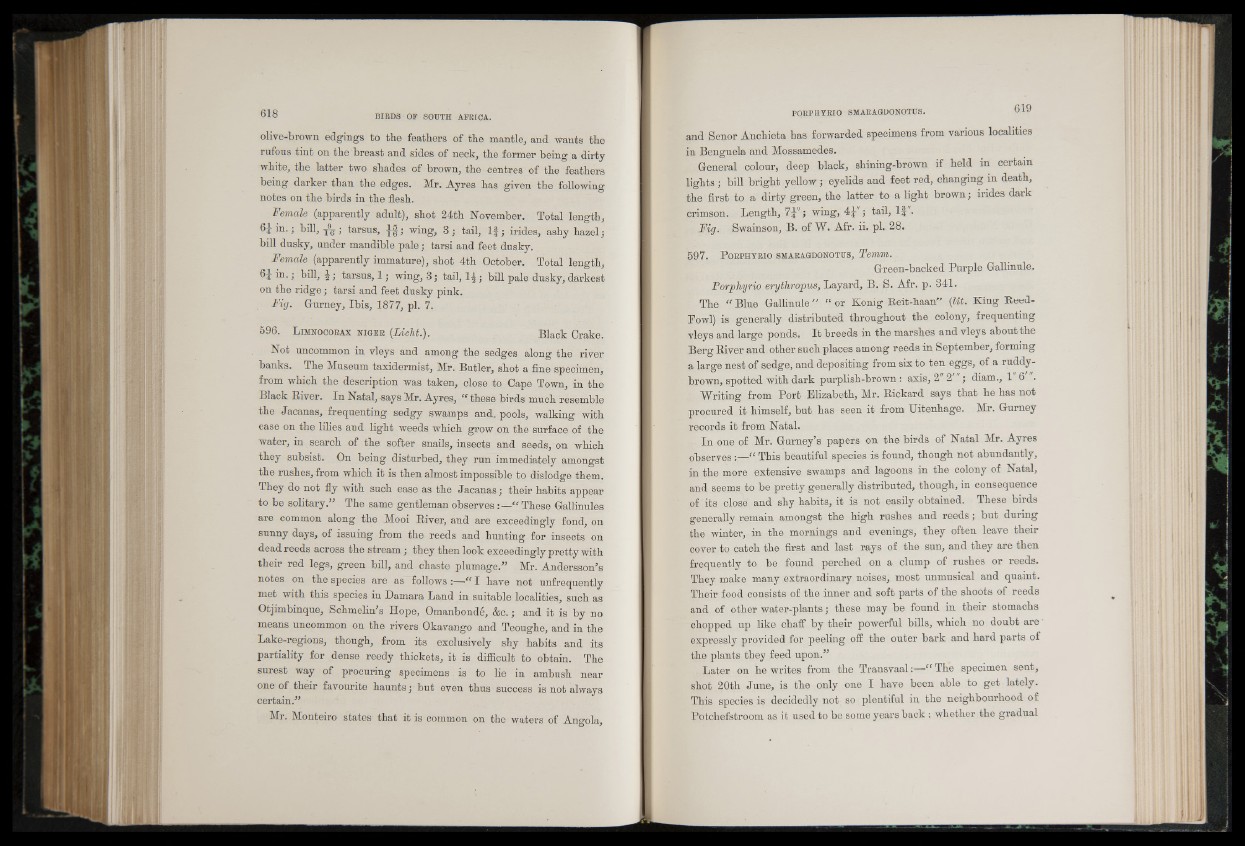
olive-brown edgings to the feathers of the mantle, and wants the
rufons tint on the breast and sides of neck, the former being a dirty
white, the latter two shades of brown, the centres of the feathers
being darker than the edges. Mr. Ayres has given the following
notes on the birds in the flesh.
Female (apparently adult), shot 24th November. Total length,
6J in.; bill, ; tarsus, wing, 3; tail, I f ; irides, ashy hazel;
bill dusky, under mandible pale; tarsi and feet dusky.
Female (apparently immature), shot 4th October. Total length,
64 | | f > bill, ^ ; tarsus, 1 ; wing, 3; tail, 1 ^ ; bill pale dusky, darkest
on the ridge; tarsi and feet dusky pink.
Fig. G-urney, Ibis, 1877, pi. 7.
596. L im n o c o e a x n i g e r (LicTit.). Black Crake.
Not uncommon in vleys and among the sedges along the river
banks. The Museum taxidermist, Mr. Butler, shot a fine specimen,
from which the description was taken, close to Cape Town, in the
Black River. In Natal, says Mr. Ayres, “ these birds much resemble
the Jacanas, frequenting sedgy swamps and. pools, walking with
ease on the lilies and light weeds which grow on the surface of the
water, in search of the softer snails, insects and seeds, on which
they subsist. On being disturbed, they run immediately amongst
the rushes, from which it is then almost impossible to dislodge them.
They do not fly with such ease as the Jacanas ; their habits appear
to be solitary.” The same gentleman observes “ These Gallinules
are common along the Mooi River, and are exceedingly fondj on
sunny days, of issuing from the reeds and hunting for insects on
dead reeds across the stream; they then look exceedingly pretty with
their red legs, green bill, and chaste plumage.” Mr. Andersson^s
notes on the species are as follows :—“ I have not unfrequently
met with this species in Damara Land in suitable localities, such as
Otjimbinque, Schmelin’s Hope, Omanbonde, &c.; and it is by no
means uncommon on the rivers Okavango and Teoughe, and in the
Lake-regions, though, from its exclusively shy habits and its
partiality for dense reedy thickets, it is difficult to obtain. The
surest way of procuring specimens is to lie in ambush near
one of their favourite haunts; but even thus success is not always
certain.”
Mr. Monteiro states that it is common on the waters of Angola,
and Senor Anchieta has forwarded specimens from various localities
in Benguela and Mossamedes.
General colour, deep black, shining-brown if held in certain
lights ; bill bright yellow; eyelids and feet red, changing in death,
the first to a dirty green, the latter to a light brown; irides dark
crimson. Length, 7J"; wing, 4 j '; tail, I f .
Fig. Swainson, B. of W. Afr. ii. pi. 28.
597. P o r ph y r io smaragdonotus, Temm.
Green-backed Purple Gallinule.
Porphyrio erythropus, Layard, B. S. Afr. p. 341.
The “ Blue Gallinule ” “ or Kpnig Reit-haan” {lit. King Reed-
Fowl) is generally distributed throughout the colony, frequenting
vleys and large ponds. It breeds in the marshes and vleys about the
Berg River and other such places among reeds in September, forming
a large nest of sedge, and depositing from six to ten eggs, of a ruddy-
brown, spotted with dark purplish-brown : axis, 2" 2'"; diam., 1 ' 6 .
Writing from Port Elizabeth, Mr. Rickard says that he has not
procured it himself, but has seen it from Uitenhage. Mr. Gurney
records it from Natal.
In one of Mr. Gurney’s papers on the birds of Natal Mr. Ayres
observes :—“ This beautiful species is found, though not abundantly,
in the more extensive swamps and lagoons in the colony of Natal,
and seems to be pretty, generally distributed, though, in consequence
of its closb and shy habits, it is not easily obtained. These birds
generally remain amongst the high rushes and reeds; but during
the winter, in the mornings and evenings, they often leave their
cover to catch the first and last rays of the sun, and they are then
frequently to be found perched on a clump of rushes or reeds.
They make many extraordinary noises, most unmusical and quaint.
Their food consists of the inner and soft parts of the shoots of reeds
and of other water-plants; these may be found in their stomachs
chopped up like chaff by their powerful bills, which no doubt are
expressly provided for peeling off the outer bark and hard parts of
the plants they feed upon.”
Later on he writes from the Tr a n s v a a lTh e specimen sent,
shot 20th June, is the only one I have been able to get lately.
This species is decidedly not so plentiful in the neighbourhood of
Potchefstroom as it used to be some years back : whether the gradual